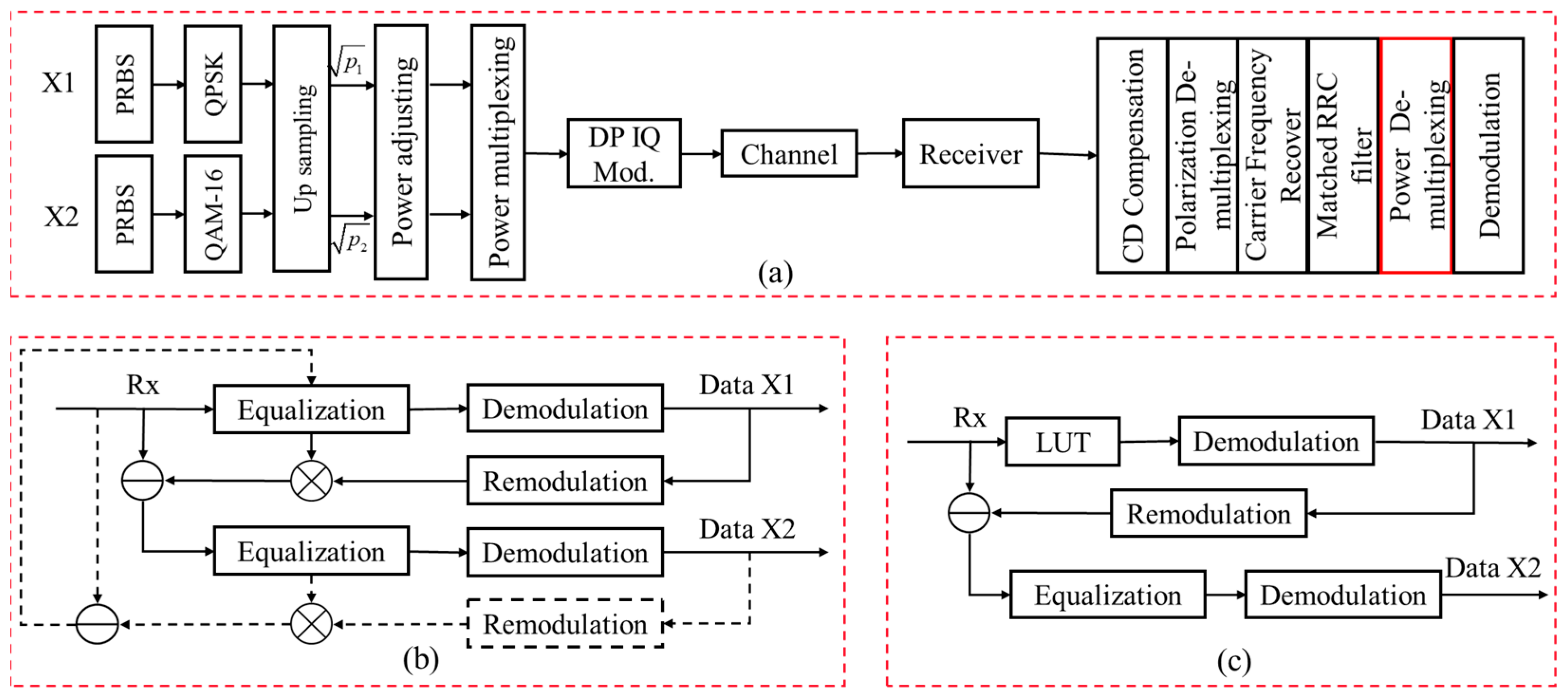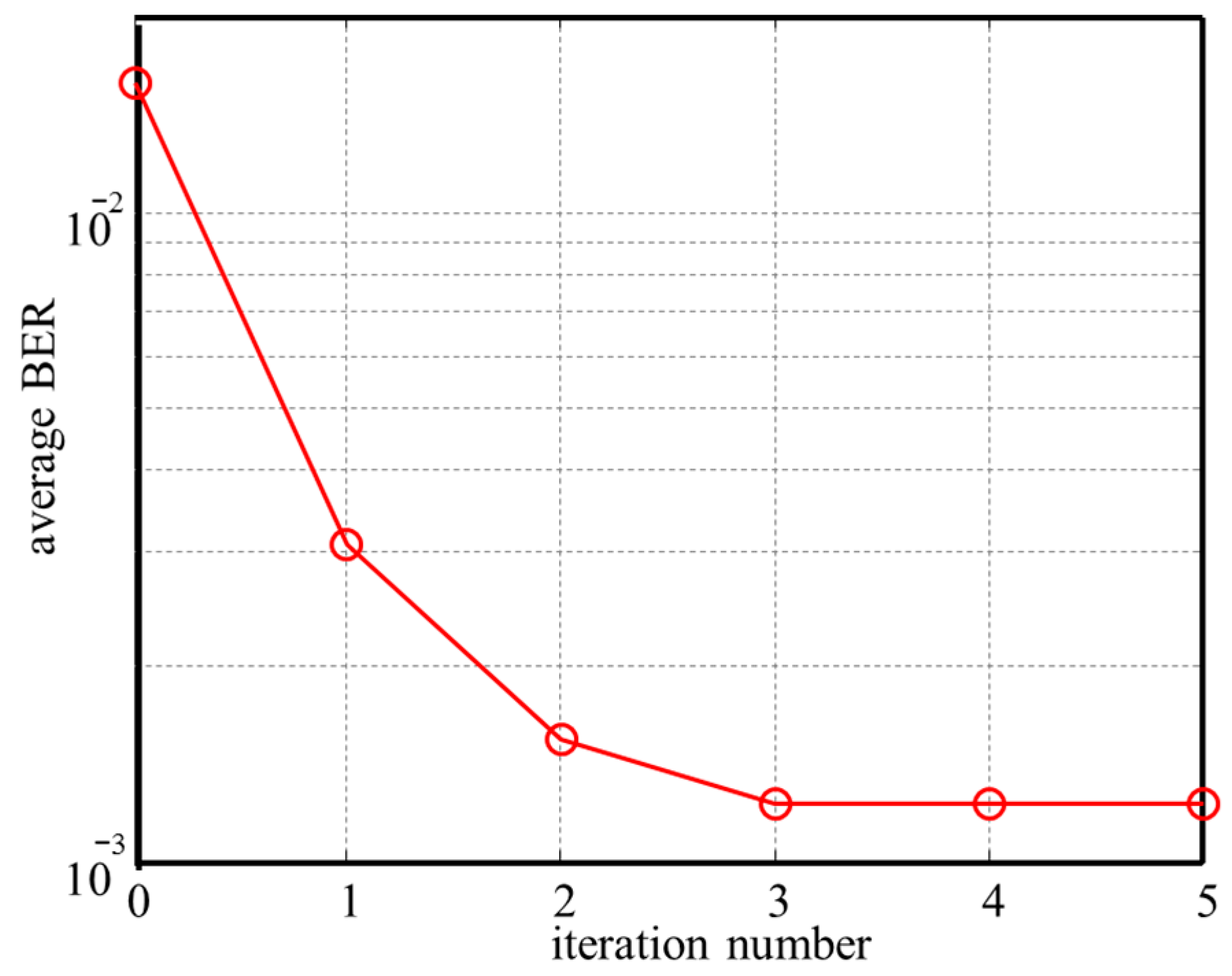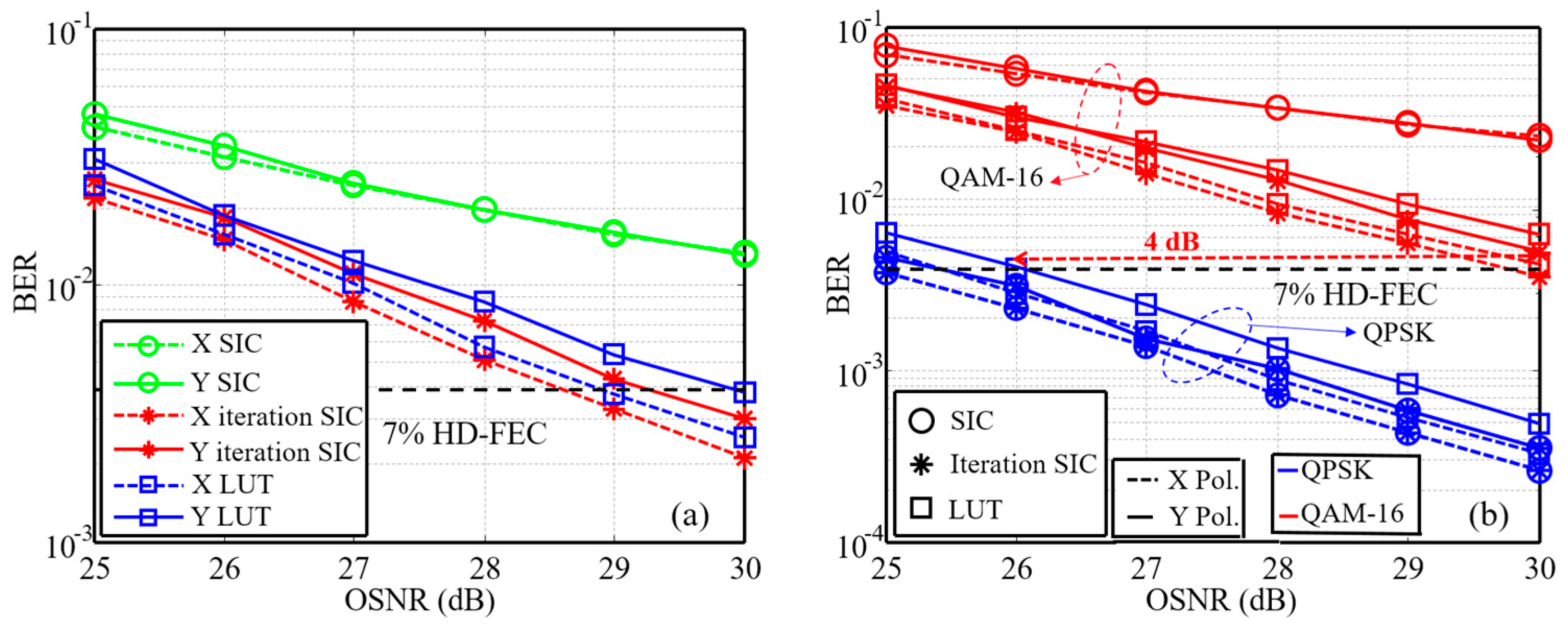Power Domain Hybrid Modulation-Based Coherent Optical Transmission with Successive Interference Cancelation
Abstract
1. Introduction
- An integrated, single-channel PDHM architecture. Departing from traditional multi-transmitter PDHM systems that generate and transmit component signals (e.g., QPSK, 16-QAM) via independent TXDSPs and physical channels, our scheme digitally synthesizes the entire PDHM constellation within a single TXDSP. This integrated signal is then transmitted through a unified transceiver and a single channel. This architectural shift eliminates the need for multiple synchronized hardware paths, resulting in a system that is more hardware-efficient, cost-effective, and flexible for practical deployment.
- A novel iterative SIC algorithm is proposed to break the error propagation cycle. A fundamental limitation of traditional SIC is its vulnerability to error propagation, where imperfections in the initial demodulation of the high-power signal lead to failure in recovering the low-power signal. This paper’s key algorithmic breakthrough is an iterative SIC process that introduces a critical feedback loop. This loop uses the initially decoded low-power signal to refine the estimation and cancelation of the high-power interference, thereby breaking the error propagation cycle and achieving a demonstrable performance improvement of approximately one order of magnitude in BER.
- The co-design of PDHM and iterative SIC is the most significant contribution of this paper, these two innovations are mutually enabling. The integrated PDHM architecture produces a deterministic signal perfectly suited for the iterative SIC algorithm. In turn, the iterative SIC provides the robust, low-error de-modulation capability necessary to decode the complex, single-channel PDHM signal. This co-design results in a complete, high-performance, and practical communication system that not only enhances spectral and power efficiency but also introduces inherent flexibility for multi-service provisioning.
2. The Principle of the Power Domain Signal Multiplexing and De-Multiplexing
3. Demonstration and Results
4. Conclusions
Author Contributions
Funding
Data Availability Statement
Acknowledgments
Conflicts of Interest
References
- IEEE 802.3 Ethernet Working Group. Available online: http://www.ieee802.org/3/bs/ (accessed on 15 January 2018).
- Camera, M.; Olsson, B.E.; Bruno, G. Beyond 100 Gbit/s: System implications towards 400 G and 1 T. In Proceedings of the 36th European Conference and Exhibition on Optical Communication, Turin, Italy, 19–23 September 2010; pp. 1–15. [Google Scholar]
- Zhou, Y.; Xu, Z.; Lu, Z.; Dong, F.; Yao, L.; Zhou, Y.; Chi, N. 47 Gbps 100 m ultra-high-speed free-space visible light tricolor laser communication system utilizing time domain hybrid Huffman coding. Opt. Express 2024, 32, 24811–24825. [Google Scholar] [CrossRef] [PubMed]
- Zhou, J.; Yu, J.; Cheng, Q.; Shi, J.; Guo, M.; Tang, X.; Qiao, Y. 256-QAM Interleaved Single Carrier FDM for Short Reach Optical Interconnects. IEEE Photonics Technol. Lett. 2017, 29, 1796–1799. [Google Scholar] [CrossRef]
- Li, Z.; Erkılınc, M.S.; Shi, K.; Sillekens, E.; Galdino, L.; Xu, T.; Thomsen, B.C.; Bayvel, P.; Killey, R.I. Spectrally Efficient 168 Gb/s/λ WDM 64-QAM Single-Sideband Nyquist-Subcarrier Modulation with Kramers–Kronig Direct Detection Receivers. IEEE J. Light. Technol. 2018, 36, 1340–1346. [Google Scholar] [CrossRef]
- Geng, Z.; Tang, X.; Zhang, X.P.; Dong, Y. Layered hybrid PAM-DMT for IM/DD OWC systems. Opt. Express 2023, 31, 32383–32392. [Google Scholar] [CrossRef] [PubMed]
- Ding, J.; Zhang, L.; Liu, J.; Li, W.; Wang, Y.; Wang, K.; Zhao, L.; Zhou, W.; Zhang, J.; Zhu, M.; et al. THz-over-fiber transmission with a net rate of 5.12 Tbps in an 80 channel WDM system. Opt. Lett. 2022, 47, 3103–3106. [Google Scholar] [CrossRef] [PubMed]
- Zhu, Y.; Zhang, C.; Lin, J.; Xu, Y.; Zhuge, Q.; Hu, W.; Chen, Z.; Xie, X. 2036Tb/s CPRI-Equivalent rate 1024-QAM DA-RoF fronthaul with comb-based WDM and SDM superchannel. In Proceedings of the 2023 Optical Fiber Communications Conference and Exhibition (OFC), San Diego, CA, USA, 5–9 March 2023; pp. 1–3. [Google Scholar]
- Yin, L.; Zhu, Y.; Wu, Q.; Jiang, H.; Zhuge, Q.; Hu, W. Pilot-Tone Assisted Successive Interference Cancellation for Uplink Power- and Frequency-Division Multiplexing Passive Optical Network. J. Light. Technol. 2022, 40, 4237–4245. [Google Scholar] [CrossRef]
- Tong, W.; Ding, J.; Meng, J.; Xu, X.; Zhang, J.; Hua, B.; Cai, Y.; Lei, M.; Xin, Z.; Yu, J.; et al. 400-Gbit/s Net Rate DP-OFDM Signals Fiber-THz -Fiber Seamless Transmission Employing Hybrid Time-Frequency-Polarization Domain Equalization. J. Light. Technol. 2024, 42, 5148–5155. [Google Scholar] [CrossRef]
- Shen, W.; Li, G.; Xing, S.; Li, Z.; Yan, A.; Wang, J.; Zhang, J. Beyond 100G three-dimensional flexible coherent PON with time, frequency, and power resource-allocation capabilities. J. Opt. Commun. Netw. 2024, 16, 516–526. [Google Scholar] [CrossRef]
- Geng, Y.; Huang, X.; Cui, W.; Ling, Y.; Xu, B.; Zhang, J.; Yi, X.; Wu, B.; Huang, S.; Qiu, K.; et al. Terabit optical OFDM superchannel transmission via coherent carriers of a hybrid chip-scale soliton frequency comb. Opt. Lett. 2018, 43, 2406–2409. [Google Scholar] [CrossRef] [PubMed]
- Gunawan, W.; Hendra, W.; Liu, Y.; Chow, C.; Chang, Y.; Yeh, C. High Speed Visible Light Communication Using Digital Power Domain Multiplexing of Orthogonal Frequency Division Multiplexed (OFDM) Signals. Photonics 2021, 8, 500. [Google Scholar] [CrossRef]
- Wei, Z.; Zhang, J.; Li, W.; St-Arnault, C.; Bernal, S.; Khalil, M.; Gutierrez-Castrejon, R.; Chen, L.R.; Plant, D.V. The role of Power-division non-orthogonal multiplexing access (NOMA) for enhancing density and fairness of different coherent optical metro-access networks. In Proceedings of the ECOC 2024; 50th European Conference on Optical Communication, Frankfurt, Germany, 22–26 September 2024; pp. 9–12. [Google Scholar]
- Jian, Y.-H.; Wang, C.-C.; Chen, J.-W.; Wei, T.-C.; Chow, C.-W.; Yeh, C.-H. Optical beam steerable and beam dividable of non-orthogonal multiple access (NOMA) signal with low-density parity-check (LDPC) for multi-user optical wireless communication system. In Proceedings of the 2024 Optical Fiber Communications Conference and Exhibition (OFC), San Diego, CA, USA, 24–28 March 2024; pp. 1–3. [Google Scholar]
- Lee, J.; Park, J.; Han, S.-K. OFDM-NOMA optical transmission utilizing dispersion-induced power fading of SMF for multi-distance PON. J. Light. Technol. 2025, 43, 4607–4615. [Google Scholar] [CrossRef]
- Krishna, G.; Gupta, S. Pre-emphasis assisted mixed modulation PD-NOMA-OFDM system for UOWC. J. Light. Technol. 2025, 43, 6766–6775. [Google Scholar] [CrossRef]








| Fiber Length | 80 km | Receiver Sensitivity | 0.8 A/W |
|---|---|---|---|
| Fiber dispersion | 16 ps/nm | Thermal noise | 10.0 × 10−12 A/Hz1/2 |
| Fiber nonlinear index | 2.6 × 10−20 m2/W | Received optical power | −5 dBm |
| Polarization mode dispersion coefficient | 0.1 × 10−12/31.62 s/sqrt(m) | LO power | 0 dBm |
| Modulation formats | QPSK and 16QAM | CD compensation | Frequency compensation |
| Rx equalizer | 13 taps FFE | RRC roll-off factor | 0.01 |
| Characteristics | Iterative SIC | LUT |
|---|---|---|
| Complexity | based on FFE | based on the modulation order |
| Feasibility | high, applicable to existing DSP-compatible systems | low, especially for high-order modulation signals. |
| Robustness to signal distortion | high, adaptive update | low, sensitive to dynamic changes |
| Performance | preferred | inferior |
| Description | Iteration SIC | Standard SIC |
|---|---|---|
| Taps number of one FFE | 13 | 13 |
| Number of iterations | 1 | 0 |
| Total number of FFE | 4 | 2 |
| Total number of complex multiplications | 52 | 26 |
| Total number of complex additions | 48 | 24 |
Disclaimer/Publisher’s Note: The statements, opinions and data contained in all publications are solely those of the individual author(s) and contributor(s) and not of MDPI and/or the editor(s). MDPI and/or the editor(s) disclaim responsibility for any injury to people or property resulting from any ideas, methods, instructions or products referred to in the content. |
© 2025 by the authors. Licensee MDPI, Basel, Switzerland. This article is an open access article distributed under the terms and conditions of the Creative Commons Attribution (CC BY) license (https://creativecommons.org/licenses/by/4.0/).
Share and Cite
Zhang, X.; Geng, Y. Power Domain Hybrid Modulation-Based Coherent Optical Transmission with Successive Interference Cancelation. Photonics 2025, 12, 1142. https://doi.org/10.3390/photonics12111142
Zhang X, Geng Y. Power Domain Hybrid Modulation-Based Coherent Optical Transmission with Successive Interference Cancelation. Photonics. 2025; 12(11):1142. https://doi.org/10.3390/photonics12111142
Chicago/Turabian StyleZhang, Xiaoling, and Yong Geng. 2025. "Power Domain Hybrid Modulation-Based Coherent Optical Transmission with Successive Interference Cancelation" Photonics 12, no. 11: 1142. https://doi.org/10.3390/photonics12111142
APA StyleZhang, X., & Geng, Y. (2025). Power Domain Hybrid Modulation-Based Coherent Optical Transmission with Successive Interference Cancelation. Photonics, 12(11), 1142. https://doi.org/10.3390/photonics12111142




